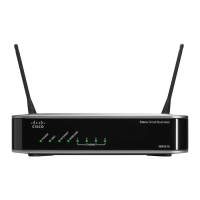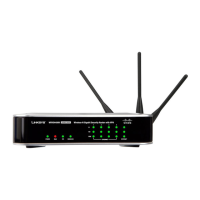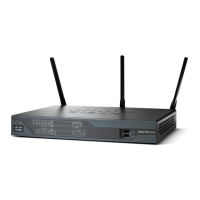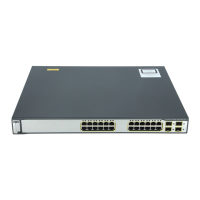Configuring a Virtual Private Network (VPN)
VPN > IPSec VPN
Cisco Small Business WRV210 Administration Guide 70
5
• Host: Directs the traffic, using port forwarding, to the correct computer. The
VPN tunnel terminates at the router with this setting. Use Port Range
Forwarding to direct traffic to the correct computer. For more information,
see “Enabling Port Forwarding to Allow Access to Services” on page 51.
STEP 4 In the Remote Secure Group section, enter the following information to identify
the computer(s) on the remote end of the tunnel that can access the tunnel.
From the drop-down menu, choose the option that you want:
• IP Addr.: Allows a specified computer to access the tunnel. Enter the IP
Address of the remote VPN router. The Mask appears.
• Subnet: Allows the entire network to access the tunnel. Enter the IP
Address and Mask of the remote VPN router in the fields provided. To allow
access to the entire IP subnet, enter 0 for the last set of IP Address, as in the
following example: 192.168.1.0.
• Host: Terminates VPN at the Router, instead of the PC. Use Port Range
Forwarding to direct traffic to the correct computer. For more information,
see “Enabling Port Forwarding to Allow Access to Services” on page 51.
• Any: Allows any computer to access the tunnel.
STEP 5 In the Remote Secure Gateway section, identify the VPN device, such as a second
VPN router, on the remote end of the VPN tunnel. Enter the IP Address of the VPN
device at the other end of the tunnel.
NOTE The remote VPN device can be another VPN router, a VPN server, or a
computer with VPN client software that supports IPSec. The IP address may
either be static (permanent) or dynamic, depending on the settings of the
remote VPN device.
• If the IP Address is static, select IP Addr. and enter the IP address. Make sure
that you have entered the IP address correctly, or the connection cannot be
made. Remember, this is NOT the IP address of the local VPN Router; it is the
IP address of the remote VPN router or device with which you wish to
communicate.
• If the IP address is dynamic, select FQDN for DDNS or Any.
- If FQDN is selected, enter the domain name of the remote router, so the
Router can locate a current IP address using DDNS.
- If Any is selected, then the Router accepts requests from any IP address.

